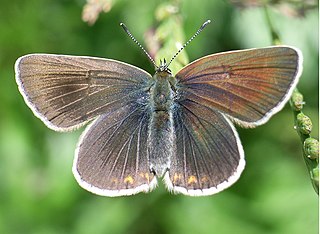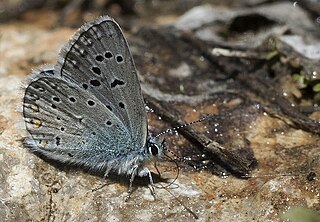
The common blue butterfly or European common blue is a butterfly in the family Lycaenidae and subfamily Polyommatinae. The butterfly is found throughout the Palearctic and has been introduced to North America. Butterflies in the Polyommatinae are collectively called blues, from the coloring of the wings. Common blue males usually have wings that are blue above with a black-brown border and a white fringe. The females are usually brown above with a blue dusting and orange spots.

Polyommatus is a genus of butterflies in the family Lycaenidae. Its species are found in the Palearctic realm.

Polyommatus eros, the Eros blue or common meadow blue, is a species of blue butterfly found in the Palearctic.

Lichk is a village in the Meghri Municipality of the Syunik Province in Armenia.

Eumedonia eumedon, the geranium argus, is a butterfly of the family Lycaenidae. It is found in the Palearctic realm. This butterfly has been included in the genera Plebejus, Plebeius, Polyommatus and Aricia, but recent molecular studies have demonstrated that Eumedonia is a valid genus, different from the previous genera mentioned.

Polyommatus damon, the Damon blue, is a butterfly of the family Lycaenidae.

Polyommatus daphnis, the Meleager's blue, is a butterfly of the family Lycaenidae.

Polyommatus myrrha is a species of butterfly in the family Lycaenidae. It was first described as Lycaena myrrha by Gottlieb August Wilhelm Herrich-Schäffer in 1851 in the six volume Systematische Bearbeitung der Schmetterlinge von Europa. This rare species has been found in Anatolia area of Turkey. and in the Zangezur Mountains, which is inhabited by subspecies P. m. cinyraeaNekrutenko & Effendi, 1979.
Polyommatus andronicus is a butterfly in the family Lycaenidae. It is found in north-eastern Greece and south-western Bulgaria, where it inhabits the mountain ranges Slavyanka and southern Pirin.

Polyommatus admetus, the anomalous blue, is a butterfly of the family Lycaenidae. It was described by Eugenius Johann Christoph Esper in 1783. It is found in south-eastern Europe and Turkey.

Polyommatus alcestis is a butterfly of the family Lycaenidae. It was described by Hans Zerny in 1932. It is found in Turkey, Iran and the Levant.
Polyommatus antidolus is a butterfly in the family Lycaenidae. It was described by Hans Rebel in 1901. It is found in Turkey.
Polyommatus arasbarani, the Arasbaran anomalous blue, is a butterfly of the family Lycaenidae. It was described by Carbonell & Naderi in 2000. It is endemic of southern slope of the Meghri Mountains in Armenia and nearby Arasbaran Mountains in northern Iran. Armenia is inhabited by subspecies P. a. neglecta. It inhabits forests alternated with dry steppe-like areas at elevations of 1700–2000 m above sea level. The species is included in the Red Book of Animals of the Republic of Armenia as endangered EN B1a+B2a, although in the book it is still called with the invalid name - Agrodiaetus neglectus.
Forster's BluePolyommatus aserbeidschanus is a butterfly in the family Lycaenidae. It was described by Walter Forster in 1956. It is found in the Caucasus, Armenia and Turkey.
Polyommatus baytopi is a butterfly in the family Lycaenidae. It was described by de Hubert de Lesse in 1959. Type locality is given as "Dogubayazit " [E. Turkey, Agri Prov.], at 2300m altitude. The species range is Eastern Turkey.

Lysandra corydonius, the false chalkhill blue, is a butterfly of the family Lycaenidae. The species is distributed in south-eastern Europe, Caucasus, Transcaucasia, north-eastern Turkey, and north-western Iran. L.corydonius is very similar to Lysandra coridon but a slight violet sheen is present, especially in the outer area of the wings. .It inhabits a wide variety of grasslands and woodlands. In Armenia it occurs from 1200 to 2000 m above sea level. The known larval host plants of the species in Turkey is Hippocrepis comosa, in the Caucasus - Coronilla varia. The species has not been assessed for the IUCN Red List. In Armenia from 2003 to 2013 its population increased.

Polyommatus poseidon is a butterfly of the family Lycaenidae. It was described by Julius Lederer in 1852. It is found from Kütahya in western Turkey to Artvin in north-eastern Turkey, as well as in Georgia.

Arevik National Park is one of the four protected national parks of Armenia. Occupying an area of 344 km2, it is located in the southern Syunik Province of Armenia.

Polyommatus iphigenia is a butterfly of the family Lycaenidae. It was described by Gottlieb August Wilhelm Herrich-Schäffer in 1847. It is found in the Balkans and Asia Minor.













